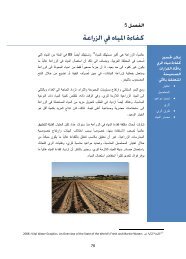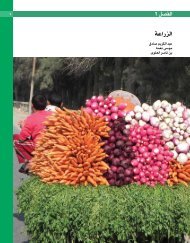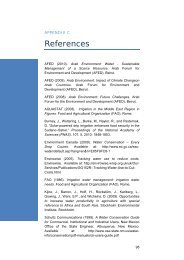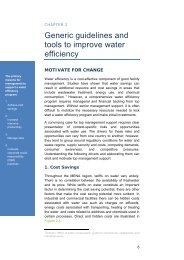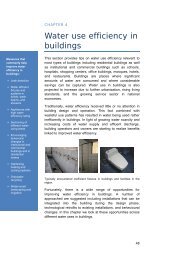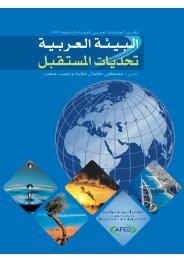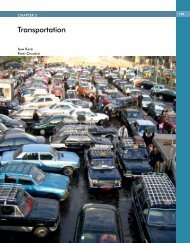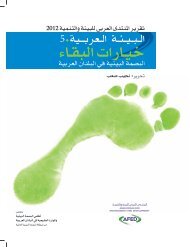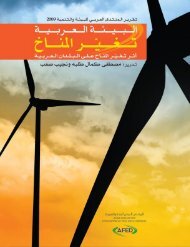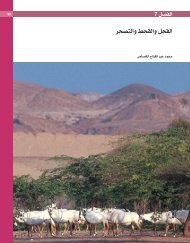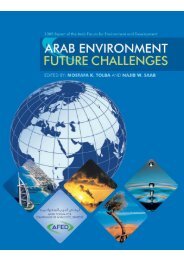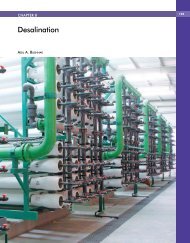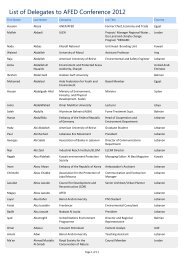Impact of Climate Change on Arab Countries - (IPCC) - Working ...
Impact of Climate Change on Arab Countries - (IPCC) - Working ...
Impact of Climate Change on Arab Countries - (IPCC) - Working ...
You also want an ePaper? Increase the reach of your titles
YUMPU automatically turns print PDFs into web optimized ePapers that Google loves.
76<br />
CHAPTER 6<br />
FRESH WATER<br />
I. INTRODUCTION<br />
The <strong>Arab</strong> world is <strong>on</strong>e <str<strong>on</strong>g>of</str<strong>on</strong>g> the most water stressed<br />
regi<strong>on</strong>s in the whole world, and climate change,<br />
which is projected to increase the frequency and<br />
intensity <str<strong>on</strong>g>of</str<strong>on</strong>g> extreme weather events such as<br />
droughts and floods, as well as decrease precipitati<strong>on</strong>,<br />
will c<strong>on</strong>tribute to even worse water scarcity<br />
in the regi<strong>on</strong>. It is not <strong>on</strong>ly the quantity <str<strong>on</strong>g>of</str<strong>on</strong>g> fresh<br />
water that might be affected by climate change,<br />
the quality <str<strong>on</strong>g>of</str<strong>on</strong>g> groundwater might also be worsened,<br />
as fresh water supplies might get c<strong>on</strong>taminated<br />
by sea water intruding coastal aquifers,<br />
thereby affecting potable water supplies for milli<strong>on</strong>s<br />
<str<strong>on</strong>g>of</str<strong>on</strong>g> <strong>Arab</strong>s.<br />
About two thirds <str<strong>on</strong>g>of</str<strong>on</strong>g> the renewable water<br />
resources <str<strong>on</strong>g>of</str<strong>on</strong>g> the <strong>Arab</strong> world originate outside the<br />
regi<strong>on</strong>. Eighty percent <str<strong>on</strong>g>of</str<strong>on</strong>g> the area <str<strong>on</strong>g>of</str<strong>on</strong>g> the <strong>Arab</strong><br />
countries is barren desert, and therefore the<br />
regi<strong>on</strong> is mainly arid with small pockets <str<strong>on</strong>g>of</str<strong>on</strong>g> semiarid<br />
climatic c<strong>on</strong>diti<strong>on</strong>s. The average annual<br />
rainfall varies between 0 and 1800 mm while the<br />
average evaporati<strong>on</strong> rate is more than 2000<br />
mm/year.<br />
The area <str<strong>on</strong>g>of</str<strong>on</strong>g> the <strong>Arab</strong> world c<strong>on</strong>tains almost ten<br />
percent <str<strong>on</strong>g>of</str<strong>on</strong>g> the dry land <strong>on</strong> earth while water<br />
resources do not exceed <strong>on</strong>e percent <str<strong>on</strong>g>of</str<strong>on</strong>g> the<br />
world’s total. Despite this water poverty, eighty<br />
percent <str<strong>on</strong>g>of</str<strong>on</strong>g> the water budget in the <strong>Arab</strong> world is<br />
allocated to agriculture, the highest water c<strong>on</strong>suming<br />
development activity, while industry<br />
c<strong>on</strong>sumes 12% and the remaining 8% is allocated<br />
to domestic and potable use. Although about<br />
2000 billi<strong>on</strong> m 3 <str<strong>on</strong>g>of</str<strong>on</strong>g> rain falls every year <strong>on</strong> the<br />
<strong>Arab</strong> countries, the amount <str<strong>on</strong>g>of</str<strong>on</strong>g> effective rainfall<br />
that is beneficially utilized is much less than this<br />
figure; huge quantities are lost in evaporati<strong>on</strong><br />
from free water surfaces, evapotranspirati<strong>on</strong> <str<strong>on</strong>g>of</str<strong>on</strong>g><br />
aquatic plants in swamps and marches, or lost to<br />
the sea or the ocean.<br />
There are 34 c<strong>on</strong>tinuously flowing fresh water<br />
rivers in the <strong>Arab</strong> world; their catchments may be<br />
as small as 86 km 2 in the case <str<strong>on</strong>g>of</str<strong>on</strong>g> the Zahrani river<br />
in Leban<strong>on</strong>, and 2.8 milli<strong>on</strong> km 2 in the case <str<strong>on</strong>g>of</str<strong>on</strong>g><br />
the Nile.<br />
The percentage <str<strong>on</strong>g>of</str<strong>on</strong>g> water used in the <strong>Arab</strong> world<br />
out <str<strong>on</strong>g>of</str<strong>on</strong>g> the total available is less than 50%, which<br />
means that almost 50% <str<strong>on</strong>g>of</str<strong>on</strong>g> the renewable water<br />
resources are still unutilized. N<strong>on</strong>etheless food<br />
imports to the regi<strong>on</strong> make up more than 50% <str<strong>on</strong>g>of</str<strong>on</strong>g><br />
food c<strong>on</strong>sumpti<strong>on</strong> and <strong>on</strong>ly 25% <str<strong>on</strong>g>of</str<strong>on</strong>g> arable land<br />
is cultivated.<br />
Annual renewable water resources in the <strong>Arab</strong><br />
regi<strong>on</strong> are about 244 billi<strong>on</strong> m 3 /year <str<strong>on</strong>g>of</str<strong>on</strong>g> which<br />
204 billi<strong>on</strong> m 3 /year are surface flows and 40 billi<strong>on</strong><br />
m 3 /year are renewable groundwater.<br />
Withdrawal in some <strong>Arab</strong> countries exceeds the<br />
renewable supplies, while others are just at the<br />
limit.<br />
It is not <strong>on</strong>ly the limited water resources that<br />
pose problems; the harsh climatic c<strong>on</strong>diti<strong>on</strong>s and<br />
the use <str<strong>on</strong>g>of</str<strong>on</strong>g> the majority <str<strong>on</strong>g>of</str<strong>on</strong>g> <strong>Arab</strong> countries’ water<br />
in water c<strong>on</strong>suming activities like agriculture add<br />
to the magnitude <str<strong>on</strong>g>of</str<strong>on</strong>g> the issue. This is exacerbated<br />
by high populati<strong>on</strong> growth rates, which add a<br />
chr<strong>on</strong>ic nature to the problem and aggravate its<br />
impact. If all this is crowned by climate change,<br />
the situati<strong>on</strong> might reach an intolerable c<strong>on</strong>diti<strong>on</strong><br />
which may ultimately affect the envir<strong>on</strong>mental,<br />
ec<strong>on</strong>omic, social, political and even security<br />
stability <str<strong>on</strong>g>of</str<strong>on</strong>g> the regi<strong>on</strong>.<br />
One <str<strong>on</strong>g>of</str<strong>on</strong>g> the major drawbacks <str<strong>on</strong>g>of</str<strong>on</strong>g> research in and<br />
<strong>on</strong> the <strong>Arab</strong> regi<strong>on</strong> is data availability: regular<br />
measurements, c<strong>on</strong>tinuous m<strong>on</strong>itoring and neutral<br />
evaluati<strong>on</strong> <str<strong>on</strong>g>of</str<strong>on</strong>g> the water status in the area is<br />
either missing or <strong>on</strong>ly available in isolated surveys<br />
that might be separated by l<strong>on</strong>g time spans with<br />
n<strong>on</strong>-available records. This adds to the uncertainty<br />
<str<strong>on</strong>g>of</str<strong>on</strong>g> the effect <str<strong>on</strong>g>of</str<strong>on</strong>g> climate change <strong>on</strong> water<br />
resources in most <str<strong>on</strong>g>of</str<strong>on</strong>g> the <strong>Arab</strong> countries. This<br />
chapter is an attempt to shed some light <strong>on</strong> climate<br />
change and climate variability as phenomena<br />
that might affect water availability in the <strong>Arab</strong><br />
regi<strong>on</strong> and how vulnerable <strong>Arab</strong> countries can<br />
mitigate and adapt to their positive and negative<br />
impacts.<br />
II. HYDROLOGICAL<br />
DIVISION OF ARAB COUNTRIES<br />
The <strong>Arab</strong> countries can be divided from the<br />
hydrologic point <str<strong>on</strong>g>of</str<strong>on</strong>g> view into the following subdivisi<strong>on</strong>s:<br />
• Al Mashrek countries: Iraq, Syria, Leban<strong>on</strong>,<br />
Jordan and Palestine.<br />
• Al Maghreb countries: Libya, Tunisia, Algeria,<br />
Mauritania and Morocco.



